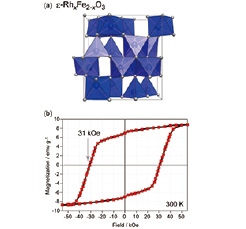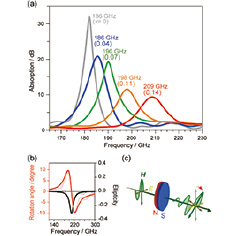Development of a Hard Magnetic Ferrite Exhibiting a Gigantic Coercivity and High Frequency Millimeter Wave Rotation
A. Namai and S. Ohkoshi
Magnetic ferrites such as Fe3O4 and Fe2O3 are extensively used because they are inexpensive and chemically stable. However, due to their low magnetocrystalline anisotropies, the coercivity of magnetic ferrites is generally low. The development of magnetic ferrites with a large coercive field (Hc) is an important issue because this type of ferrite can be used in various advanced applications.

Fig. 1. (a) Crystal structure and (b) magnetic hysteresis of ε-RhxFe2−xO3.

Fig. 2. (a) Electromagnetic wave absorption properties of ε-RhxFe2−xO3 measured by THz-TDS. (b) Rotation angle and ellipticity of the magnetized ε-Rh0.14Fe1.86O3 pellet. (c) The schematic illustration of millimeter wave rotation.
In this work, we prepared rhodium-substituted ε-Fe2O3, ε-RhxFe2−xO3 nanomagnets, by a nanoscale chemical synthesis using mesoporous silica as a template. The transmission electron microscope image indicates that the obtained sample is composed of nanoparticles with an average particle size of ca. 35 nm. The X-ray diffraction patterns confirmed that the crystal structure is orthorhombic with Pna21 space group (Fig. 1a). The magnetic hysteresis loops measured at room temperature show that the Hc value increased with rhodium substitution and ε-Rh0.14Fe1.86O3 exhibits a huge Hc value of 27 kOe. Furthermore, as shown in Figure 1b, a crystallographically oriented ε-Rh0.14Fe1.86O3 nanomagnet recorded an Hc value of 31 kOe, which is the largest value among metal-oxide-based magnets and is comparable to those of rare-earth magnets (Hc values of Sm-Co and Nd-Fe-B magnet are 30 kOe and 25 kOe, respectively). Such a gigantic Hc value is explained by the following reasons. The particle size in the present series should be sufficiently small to form a single magnetic domain. In addition, the results of the first-principles calculations indicate strong Fe–O hybridization causing a non-zero orbital angular momentum on the Fe ion, which induces a large magnetocrystalline anisotropy. Furthermore, Rh–O–Fe hybridization is observed around the Rh substituted site, which enhances the magnetocrystalline anisotropy through the contribution from the orbital angular momentum on Rh.
Insulating magnetic materials with high magnetic anisotropy is expected to show high-frequency zero-field ferromagnetic resonance (natural resonance). The electromagnetic wave absorption properties of ε-RhxFe2−xO3 were measured under zero-magnetic field at room temperature using terahertz time domain spectroscopy (THz-TDS). As shown in Figure 2a, resonance frequencies (fr) were observed at 182 GHz (x = 0), 186 GHz (x = 0.04), 190 GHz (x = 0.07), 198 GHz (x = 0.11), and 209 GHz (x = 0.14). The observed fr values are the highest among all magnetic materials. Furthermore, a magnetized ε-Rh0.14Fe1.86O3 pellet sample exhibited magnetic rotation and ellipticity change of the propagated millimeter wave at 220 GHz, which is caused by gyromagnetic effect (Fig. 2b and 2c).
The gigantic Hc value has potential to be applied in future high-density magnetic recording media because the large Hc value enables the particle size to be greatly reduced while maintaining ferromagnetic properties. In addition, ε-RhxFe2−xO3 exhibits zero-field ferromagnetic resonance up to 209 GHz, and magnetic rotation of the propagated millimeter wave occurs due to an optically induced magnetic dipole transition at 220 GHz. The present material should be useful for high frequency millimeter wave absorbers and rotators (isolators or circulators) since it should restrict electromagnetic interference problems because the frequency of the magnetic rotation corresponds to the highest window of air (220 GHz band), which is the anticipated carrier frequency for next-generation millimeter wave wireless communications.
References
- A. Namai, M. Yoshikiyo, K. Yamada, S. Sakurai, T. Goto, T. Yoshida, T. Miyazaki, M. Nakajima, T. Suemoto, H. Tokoro, and S. Ohkoshi, Nature Communications 3, 1035 (2012). [Nature Materials "Research Highlights" and Nature Japan "Focused Articles"]
